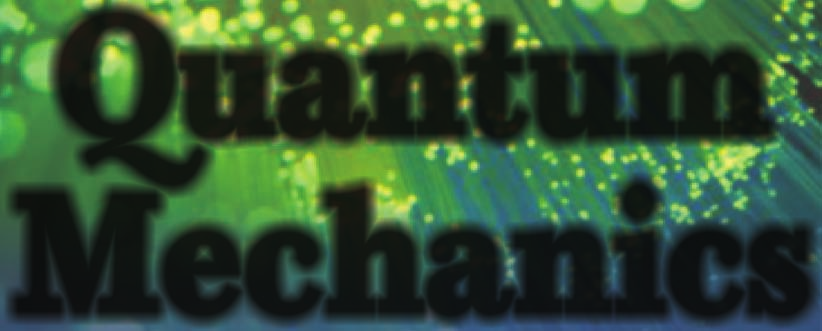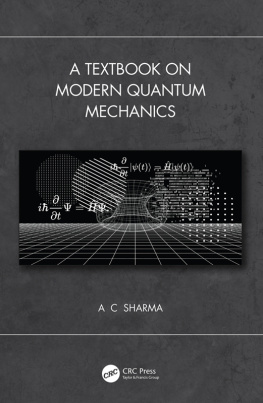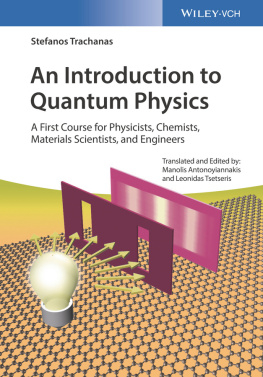





 QUANTUM MECHANICS A Textbook for Undergraduates Mahesh C. JainFormerly Associate ProfessorDepartment of PhysicsHindu CollegeUniversity of Delhi New Delhi-110001 2011 QUANTUM MECHANICS: A Textbook for Undergraduates Mahesh C. Jain 2007 by PHI Learning Private Limited, New Delhi. All rights reserved. No part of this book may be reproduced in any form, by mimeograph or any other means, without permission in writing from the publisher. Second Printing.........April, 2011 Published by Asoke K. Second Printing.........April, 2011 Published by Asoke K.
QUANTUM MECHANICS A Textbook for Undergraduates Mahesh C. JainFormerly Associate ProfessorDepartment of PhysicsHindu CollegeUniversity of Delhi New Delhi-110001 2011 QUANTUM MECHANICS: A Textbook for Undergraduates Mahesh C. Jain 2007 by PHI Learning Private Limited, New Delhi. All rights reserved. No part of this book may be reproduced in any form, by mimeograph or any other means, without permission in writing from the publisher. Second Printing.........April, 2011 Published by Asoke K. Second Printing.........April, 2011 Published by Asoke K.
Ghosh, PHI Learning Private Limited, M-97, Connaught Circus, New Delhi-110001 and Printed by Mudrak, 30-A, Patparganj, Delhi-110091. Dedicated to my late parentsShri Sham Lal JainSmt. Lakshmi Devi JainQuantum mechanics is very impressive. But an inner voicetells me that it is not yet the real thing. The theory producesa great deal but hardly brings us closer to the secret of theOld One. I am at all events convinced that He does notplay dice. Einstein God not only plays dice.
He also sometimes throws the dicewhere they cannot be seen! Stephen Hawking ContentsPrefacexiiiChapter 1Historical Introduction Nobel Awards for the Development of Quantum Theory Chapter 2 Particle Nature of Radiation: The Origin of QuantumTheory 2.1 Blackbody Radiation: Plancks Quantum Hypothesis Plancks Radiation Law 2.2 The Photoelectric Effect Failure of Classical Physics Einsteins TheoryPhotons Stopping Potential 2.3 The Compton Effect Experimental Arrangement Failure of Classical Physics Comptons Explantation Relation between q and f Kinetic Energy of the Recoil Electron 2.4 Dual Nature of Radiation Conceptual Difficulty Summary27Questions28ExercisesChapter 3Atoms and the Bohr Model3253 3.1 Introduction Alpha-Scattering Experiment The Rutherford Nuclear Model 3.2 Atomic Spectra viiviiiContents 3.3 Bohr Model of Hydrogenic Atoms Energy of the Electron in the n th Bohr Orbit Frequency and Wavelength of the Radiation in the Transition n 2 n 1 3.4 Explanation of the Hydrogen Spectrum Hydrogenic Ions 3.5 Correction for Finite Nuclear Mass 3.6 Limitations of the Bohr Model. Sommerfelds Elliptic Orbits 3.7 The Franck-Hertz Experiment 3.8 The Correspondence Principle Summary51Questions52ExercisesChapter 4Wave Nature of Matter and the Need fora Wave Function5470 4.1 De Broglies Hypothesis Other Useful Expressions for the De Broglie Wavelength 4.2 Experimental Verification of De Broglies Hypothesis Davisson-Germer Experiment G.P. Thomsons Experiment 4.3 The Double-Slit Experiment with Particles 4.4 The Need for a Wave Function 4.5 Borns Interpretation of the Wave Function Summary69Questions69Exercises70Chapter 5Wave Packets and the Uncertainty Principle7196 5.1 Representation of a Particle by a Wave Packet Wave Packets in Three Dimensions 5.2 Heisenbergs Uncertainty Principle Energy-Time Uncertainty Relation General Statement of the Uncertainty Principle 5.3 Illustrations of the Uncertainty Principle Heisenbergs Gamma-ray Microscope Single-Slit Diffraction Experiment Double-Slit Interference Experiment 5.4 Applications/Consequences of the Uncertainty Principle The Ground State Energy and the Radius of the Hydrogen Atom Nonexistence of Electrons Inside the Nucleus Contentsix Zero-Point Energy of a Harmonic Oscillator Broadening of Spectral Lines Mass of p-Meson Summary94Questions95Exercises96Chapter 6The Schrdinger Equation97125 6.1 The Necessity for a Wave Equation and Conditions Imposed on It 6.2 The Time-Dependent Schrdinger Equation Particle in a Force-field 6.3 Statistical Interpretation of the Wave Function and Conservation of Probability Probability Conservation and the Hermiticity of the Hamiltonian Probability Current Density 6.4 Expectation Values of Dynamical Variables 6.5 Motion of Wave Packets: Ehrenfests Theorem 6.6 Exact Statement and Proof of the Position-Momentum Uncertainty Relation 6.7 Wave Packet Having Minimum Uncertainty Product 6.8 The Time-Independent Schrdinger Equation. Stationary States Degeneracy Reality of Eigenvalues Stationary States Orthogonality of Eigenfunctions Parity Continuity and Boundary Conditions 6.9 The Free Particle Momentum Eigenfunctions Physical Interpretation of the Wave Functions Normalization of Momentum Eigenfunctions Summary121Questions124Chapter 7Particle in a Potential Well126149 7.1 One-Dimensional Infinite Square Well Connection with the De Broglie Hypothesis Zero-Point Energy Parity 7.2 Three-Dimensional Infinite Square Well 7.3 One-Dimensional Finite Square Well (First Type) Eigenfunctions Parity Energy Levels xContents 7.4 One-Dimensional Finite Square Well (Second Type) Summary146Questions148Exercises148Chapter 8Scattering of Particles by Barriers and Wells150174 8.1 The Potential Step Case 1: E > V 0 Case 2: E < V 0 8.2 The Square Potential Barrier Case 1: E > V 0 Case 2: E < V 0 8.3 Explanation of Alpha Decay 8.4 The Square Potential Well Summary170Questions173Exercises174Chapter 9The Linear Harmonic Oscillator175192 9.1 The Time-Independent Schrdinger Equation and Its Solution. Energy Eigenvalues 9.2 The Hermite Polynomials Recurrence Relations Generating Function Rodrigues Formula Orthogonality 9.3 The Harmonic Oscillator Wave Functions Summary190Questions191Exercises191Chapter 10The Formal Structure of Quantum Mechanics193203 10.1 The Dirac Notation 10.2 Operators Hermitian Operator Commutator 10.3 Orthonormal Functions 10.4 Eigenvalues and Eigenfunctions Degeneracy Eigenfunctions of Commuting Operators 10.5 The Postulates of Quantum Mechanics Postulate 1: The Wave Function Postulate 2: The Superposition Principle Postulate 3: Operators Contentsxi Postulate 4: Expansion in Eigenfunctions Postulate 5: Measurement of an Observable: Eigenvalues Postulate 6: Expectation Values Postulate 7: Time Development of the Wave Function 10.6 A Note on the Superposition Principle Chapter 11Orbital Angular Momentum in Quantum Mechanics 204220 11.1 The Orbital Angular Momentum Operator and Its Cartesian Components 11.2 Commutation Relations 11.3 Angular Momentum Operators in Spherical Polar Coordinates 11.4 Eigenvalues and Eigenfunctions of
Next page
















 QUANTUM MECHANICS A Textbook for Undergraduates Mahesh C. JainFormerly Associate ProfessorDepartment of PhysicsHindu CollegeUniversity of Delhi New Delhi-110001 2011 QUANTUM MECHANICS: A Textbook for Undergraduates Mahesh C. Jain 2007 by PHI Learning Private Limited, New Delhi. All rights reserved. No part of this book may be reproduced in any form, by mimeograph or any other means, without permission in writing from the publisher. Second Printing.........April, 2011 Published by Asoke K. Second Printing.........April, 2011 Published by Asoke K.
QUANTUM MECHANICS A Textbook for Undergraduates Mahesh C. JainFormerly Associate ProfessorDepartment of PhysicsHindu CollegeUniversity of Delhi New Delhi-110001 2011 QUANTUM MECHANICS: A Textbook for Undergraduates Mahesh C. Jain 2007 by PHI Learning Private Limited, New Delhi. All rights reserved. No part of this book may be reproduced in any form, by mimeograph or any other means, without permission in writing from the publisher. Second Printing.........April, 2011 Published by Asoke K. Second Printing.........April, 2011 Published by Asoke K.